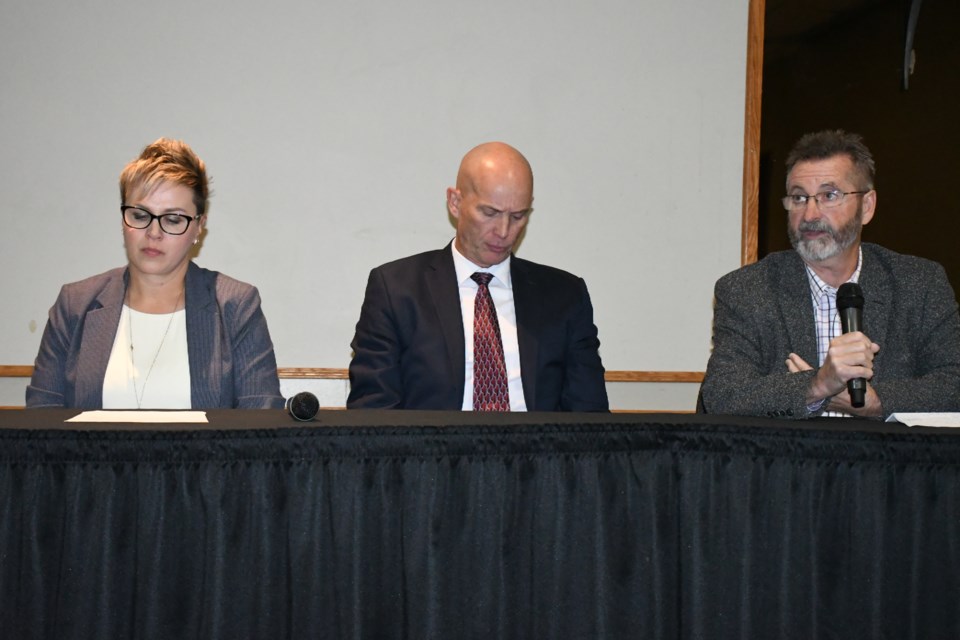The relationship between the City of Moose Jaw, Saskatchewan Polytechnic and 15 Wing Air Base is so economically entwined that whatever happens to one entity usually affects the others.
The Moose Jaw and District Chamber of Commerce held its annual general meeting on Sept. 22 at the Heritage Inn. A panel discussion featured representatives from the three groups speaking about the topic, “Drivers of the local economy.”
Jim Dixon is the city’s economic development manager, Kristin Craig is the associate dean for the school of business and information and communications technology with Sask. Polytech and Scott Greenough is director of operations for CAE, which provides flight simulators to train 15 Wing trainees.
The local economy
Dixon explained that at least 70 per cent of new jobs is based on expanding existing businesses within the community. This means having a healthy business climate is critical so existing shops can thrive and create new positions.
“You’re seeing that right now,” Dixon said.
For example, he pointed to the new Canadian Tire store that’s twice the size of the old building, the current construction of new businesses on that same site, Donald’s Fine Foods’ expansion of the former XL Beef Plant, and Brandt Industries’ creation of a trailer manufacturing plant.
“Those are good signs of a healthy community,” he added.
Benefits of Sask. Polytech
Craig explained that over 200 people work at the Moose Jaw campus, while about 2,600 students study here yearly. Many are international students, and while she had no stats about how many remain, Craig noted that 94 per cent of grads stay in the province. These alumni and the institution contribute $2.2 billion annually to Saskatchewan’s economy.
Meanwhile, the school is spending $15.6 million at its Moose Jaw campus to enhance its trade programs and new agriculture and food diploma program.
“So, really great things (are) happening on the Moose Jaw campus alone,” Craig added.
Supporting flight students
Greenough explained that a Second World War veteran started Canadian Aviation Electronics (CAE) in 1947 in Montreal, where it has remained headquartered for the past 75 years.
The company is a full-tier aerospace business focusing on civil aviation, defence and security, and health care. It employs 13,000 people worldwide, including 5,000 in Canada and roughly 200 in Moose Jaw.
CAE has been training pilots at 15 Wing Air Base for decades, but in the late 1990s, the Canadian Armed Forces brought in other industries to support further aspects of training, Greenough said. Today, CAE provides ground-based training programs, including academic and simulator training.
“Our technicians are primarily responsible for taking care of those airplanes. So we have a little over 22 of the turboprop airplanes and a little under 20 of the Hawk jet aircraft you see flying around … ,” he continued.
CAE also manages site services such as building maintenance, building modification, navigational maintenance, air traffic control, mess hall and food.
Projects to drive the economy
The economic effect that the former XL Beef Plant and Great Plains Power Station will have on Moose Jaw’s economy will be “terrific,” considering they need services such as accommodations and restaurants for their workers, said Dixon.
Dixon toured the power plant recently and thought it was impressive, especially with all the cranes on site. He noted that site manager Burns and McDonnell (B&M) has given city hall plenty of statistics about the project, while city hall learned from the City of Swift Current that its new power station — whose construction B&M managed — has had a positive effect.
Furthermore, a tour of the sow processing plant was also positive, although more external contractors are being used since fewer provincial ones could be found, Dixon continued. However, all those workers bring new money into the community, which is a “win-win” scenario.
“The impact is impressive, and we’re experiencing it now, and we should embrace it,” he added.
Training students for jobs
There are over 20 programs at Sask. Polytech’s Moose Jaw Campus, while the organization adds new programs yearly to meet the industry’s needs, said Craig. The institution also attempts to align its services with the province’s 2030 growth plan.
Some of the bigger programs at the Moose Jaw campus include the schools of business; information and communications technology; mining, engineering and manufacturing; natural resources and built environment; and trades.
“We’re contributing a lot to the local economy by bringing these students … and then (sending them) out into industry in many areas,” Craig added.
Longevity of company
CAE’s 75 years is a “pretty big milestone,” especially in the aviation industry, said Greenough. The company started in an old war hangar in Montreal and has become a globally recognized brand that is the No. 1 producer of flight sims.
“(It’s) a solid product, a solid reputation … and delivering all the time,” he remarked.
Greenough added that many Sask. Polytech graduates work at the air base, including technicians, who solve some of CAE’s biggest technical problems.
Future economic growth
There are many opportunities for economic growth in Moose Jaw and the region, said Dixon. For example, city hall is developing the 342-hectare (3,800-acre) agri-foods industrial park and wants to attract businesses focused on agriculture, food processing, and production.
City hall has also dedicated some land for Sask. Polytech’s ag and food diploma program.
“We’re really excited about that program,” said Craig.
There are opportunities at the industrial park to use geothermal that can help reduce greenhouse gases, Dixon continued. It could also be possible to use solar and green energy there.
“We’re going to work with Sask. Poly and whoever we can to develop those opportunities … ,” he remarked. “Gibson Refinery have (also) expressed interest in geothermal as an opportunity.”
Dixon added that city hall also wants to engage more with First Nations groups.




